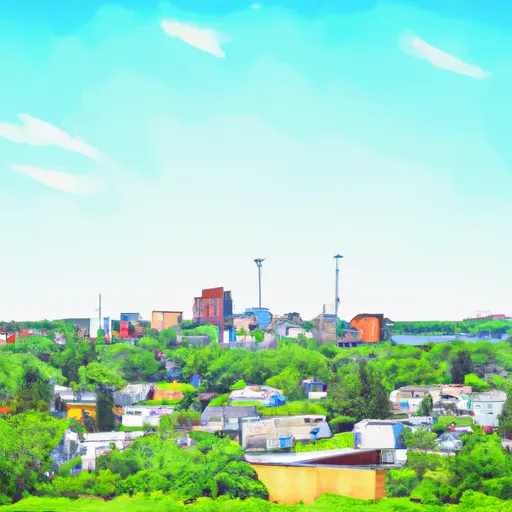-
 Snoflo Premium
Snoflo Premium
Get unlimited access to all our content
With no Ad interruptions! - Start Your Free Trial Login with existing account
Howard-Lake
Eden Index
Climate
6.3
•
Recreation
3.1
•
Community
3.4
•
Safeguard
4.5/10

Howard Lake is a small city located in Wright County, Minnesota. It experiences a humid continental climate, characterized by warm summers and cold winters. Average temperatures range from 10°F (-12°C) in winter to 80°F (27°C) in summer. Precipitation is fairly evenly distributed throughout the year, with an average of 30 inches (76 cm) annually, and snowfall is common during the winter months.
In terms of hydrology, Howard Lake is situated near several bodies of water, including Howard Lake, Dutch Lake, and Mallard Pass Lake. These lakes offer opportunities for fishing, boating, and other water-based activities, attracting outdoor enthusiasts throughout the year. Additionally, the area is crisscrossed by numerous rivers and streams, providing ample opportunities for canoeing, kayaking, and wildlife observation.
Outdoor recreation opportunities in Howard Lake extend beyond water-based activities. The city is surrounded by picturesque natural landscapes, making it ideal for hiking, camping, and picnicking. There are also several parks and trails in the area, such as Howard Lake City Park and the Crow-Hassan Park Reserve, which offer opportunities for walking, biking, and birdwatching. Overall, Howard Lake provides a variety of outdoor recreation options to suit the preferences of nature lovers.
What is the Eden Index?
The Snoflo Eden Index serves as a comprehensive rating system for regions, evaluating their desirability through a holistic assessment of climate health, outdoor recreation opportunities, and natural disaster risk, acknowledging the profound impact of these factors on livability and well-being.
Climate Health Indicator (CHI): 6.3
Howard-Lake receives approximately
750mm of rain per year,
with humidity levels near 84%
and air temperatures averaging around
7°C.
Howard-Lake has a plant hardyness factor of
4, meaning
plants and agriculture in this region thrive during a short period during spring and early summer. Most
plants will die off during the colder winter months.
By considering the ideal temperature range, reliable water supplies, clean air, and stable seasonal rain or snowpacks, the Climate Health Indicator (CHI) underscores the significance of a healthy climate as the foundation for quality living.
A healthy climate is paramount for ensuring a high quality of life and livability in a region, fostering both physical well-being and environmental harmony. This can be characterized by ideal temperatures, reliable access to water supplies, clean air, and consistent seasonal rain or snowpacks.
Weather Forecast
Streamflow Conditions
Upper Mississippi-Crow-Rum
Area Rivers
Upper Mississippi-Crow-Rum
Snowpack Depths
Upper Mississippi-Crow-Rum
Reservoir Storage Capacity
Upper Mississippi-Crow-Rum
Groundwater Levels
Recreational Opportunity Index (ROI): 3.1
The Recreational Opportunity Index (ROI) recognizes the value of outdoor recreational options, such as parks, hiking trails, camping sites, and fishing spots, while acknowledging that climate plays a pivotal role in ensuring the comfort and consistency of these experiences.
Access to outdoor recreational opportunities, encompassing activities such as parks, hiking, camping, and fishing, is crucial for overall well-being, and the climate plays a pivotal role in enabling and enhancing these experiences, ensuring that individuals can engage in nature-based activities comfortably and consistently.
Camping Areas
| Campground | Campsites | Reservations | Toilets | Showers | Elevation |
|---|---|---|---|---|---|
| Onegume | 46 | 1,338 ft | |||
| Winnie Dam | None | 1,334 ft | |||
| West Seelye Bay | 22 | 1,418 ft | |||
| Washburn Lake - Land OLakes State Forest | 30 | 1,347 ft | |||
| Ronald Cloutier - Cross Lake | 120 | 1,246 ft | |||
| Leech Lake Rec Area | 78 | 1,313 ft | |||
| Williams Narrows | 17 | 1,328 ft | |||
| East Seelye Bay | 13 | 1,342 ft | |||
| Plug Hat Point | None | 1,368 ft | |||
| Deer Lake | 48 | 1,413 ft |
Nearby Fishing
Nearby Ski Areas
Catastrophe Safeguard Index (CSI):
The Catastrophe Safeguard Index (CSI) recognizes that natural disaster risk, encompassing floods, fires, hurricanes, and tornadoes, can drastically affect safety and the overall appeal of an area.
The level of natural disaster risk in a region significantly affects safety and the overall livability, with climate change amplifying these risks by potentially increasing the frequency and intensity of events like floods, fires, hurricanes, and tornadoes, thereby posing substantial challenges to community resilience and well-being.
Community Resilience Indicator (CRI): 3.4
The Community Resilience Indicator (CRI) recognizes that education, healthcare, and socioeconomics are crucial to the well-being of a region. The CRI acknowledges the profound impact of these elements on residents' overall quality of life. By evaluating educational resources, healthcare accessibility, and economic inclusivity, the index captures the essential aspects that contribute to a thriving community, fostering resident satisfaction, equity, and social cohesion.

